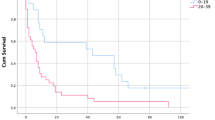Abstract
The objective of the study was to review the natural history of patients with a malignant pleural effusion but without obvious evidence of a primary, to assess the value of investigations used to look for a primary and to assess the response to palliative chemotherapy. This was done by a retrospective study of patients' notes at the Lung Unit, Royal Marsden Hospital, Sutton, Surrey. Improvement in tumour-related symptoms (and duration) on chemotherapy was assessed by the patient before the first course of chemotherapy and following each course using simple descriptive criteria as follows: (1) complete disappearance of symptoms (CR); (2) good improvement in symptoms (PR); (3) minor or no change in symptoms (NC); (4) worse symptoms (PD). Pleural effusion objective response (and duration) according to Hamed definition: success defined as a continued absence of reaccumulation of pleural fluid on all follow-up radiographs; any reaccumulation was regarded as a treatment failure. Overall survival was measured from the date of histological/cytological diagnosis to death. The study included 42 patients, 27 males and 15 females with a median age of 55 years. A primary was found in 15 patients (36%), and considered to be lung cancer. A total of 11/32 (34%) had a thoracic computed tomography (CT) scan with abnormalities compatible with a diagnosis of lung primary. When thoracic CT scan was negative, fibre optic bronchoscopy was always negative (0/13). Abdominal and pelvic CT scan, abdominal ultrasound, pelvic ultrasound and mammograms failed to reveal the primary. Twenty-three patients underwent local treatment and 37 received systemic chemotherapy. A total of 29/37 (78%) patients achieved symptomatic improvement (median duration, 6 months) and 32/37 (86%) an objective response of their pleural effusion on chemotherapy (median duration, 6 months). The median survival of the whole group was 12 months (3-60+ months). In this series the thoracic CT led to a diagnosis of lung primary in 34% of the cases. Other radiological examinations and bronchoscopy were unhelpful. Chemotherapy achieved symptom relief in 78% of patients.
This is a preview of subscription content, access via your institution
Access options
Subscribe to this journal
Receive 24 print issues and online access
$259.00 per year
only $10.79 per issue
Buy this article
- Purchase on Springer Link
- Instant access to full article PDF
Prices may be subject to local taxes which are calculated during checkout
Similar content being viewed by others
Author information
Authors and Affiliations
Rights and permissions
About this article
Cite this article
Bonnefoi, H., Smith, I. How should cancer presenting as a malignant pleural effusion be managed?. Br J Cancer 74, 832–835 (1996). https://doi.org/10.1038/bjc.1996.444
Issue Date:
DOI: https://doi.org/10.1038/bjc.1996.444
This article is cited by
-
Comparative evaluation of VATS assisted combined mechanical and chemical pleurodesis with chemical pleurodesis—is it worthwhile?
Indian Journal of Thoracic and Cardiovascular Surgery (2013)
-
Management of malignant pleural effusions
Current Respiratory Care Reports (2012)
-
Bilan paraclinique des carcinomes de site primitif inconnu
Oncologie (2008)



